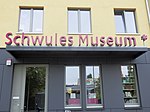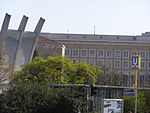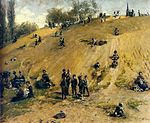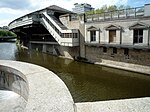Mehringdamm
Streets in Berlin

The Mehringdamm is a street in southern Kreuzberg, Berlin. In the north it starts at Mehringbrücke and ends - with its southernmost houses already belonging to Tempelhof locality - on Platz der Luftbrücke. It is the historical southbound Berlin-Halle highway, now forming the federal route 96. The main junction of Mehringdamm is with the 19th-century ring road around Berlin's inner city, named Yorckstraße west, and Gneisenaustraße east of Mehringdamm.
Excerpt from the Wikipedia article Mehringdamm (License: CC BY-SA 3.0, Authors, Images).Mehringdamm
Mehringdamm, Berlin Kreuzberg
Geographical coordinates (GPS) Address Phone number Website Nearby Places Show on map
Geographical coordinates (GPS)
| Latitude | Longitude |
|---|---|
| N 52.4917 ° | E 13.3872 ° |
Address
Landeshaupt Glaserei Glasbau
Mehringdamm 49
10961 Berlin, Kreuzberg
Germany
Open on Google Maps











